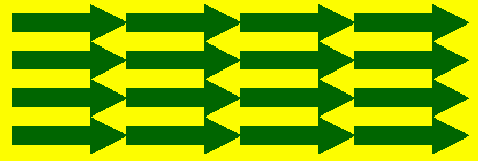Free will?
Ambiguous figures, of which the Serendip logo (circa 1994-95) is one
example, make
possible some interesting observations bearing on the existence and meaning of "free will". In most people's minds, "free will" has two relatively distinct properties. The first is the idea that what one does is in some sense "free", that is "not determined by something else". The second is the idea that one can onself control what one does.
Notice that the Serendip logo can sometimes be seen as consisting of green arrows pointing to the right, and at other times as yellow arrows pointing to the left, but is infrequently or never seen as both (unless one tries very hard).

Whether one sees right of left pointing arrows most easily can be influenced by details of the constuction of the figure (colors, exact shapes, and so forth), previous experiences with other figures, stable personal preferences, and mood. The important point, however, is that with all of these held constant (as they are as you look at the figure right at the moment), the figure can still be seen in either of two ways. In short, your perception of the figure is variable in a way that seems "not to be determined by anything else".
An additional observation implies that, in this situation, you can control what you do. To make this observation, first decide whether you want to see the Serendip logo as consisting of arrows pointing to the right or to the left. Once you have decided, you will be presented with a new image of the Serendip logo and two buttons, one indicating you are going to the right (based on Serendip's instructions) and the other indicating you are going to the left (equally based on Serendip's instructions). Push one or the other when (and ONLY when) you see the Serendip logo as you previously decided to see it. Ready? Go.